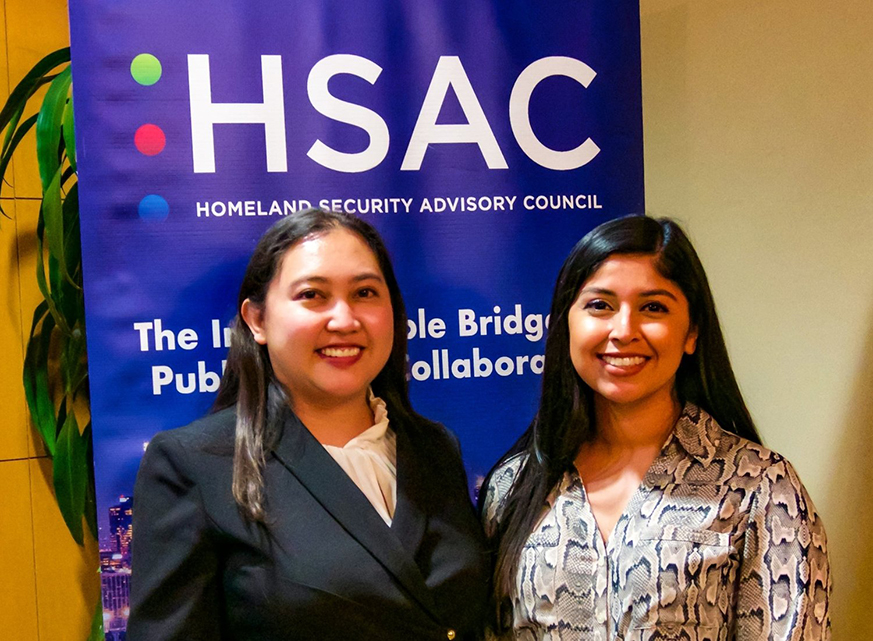CSUN Students Take First Place in Homeland Security’s Crisis Relief Challenge
This fall, two California State University, Northridge graduate students, Maryel Albarran and Elaine Angelica Linga, tackled an issue that has bedeviled the state — especially Southern California — since its urban populations took off in the 20th century. As part of a Homeland Security Advisory Council (HSAC) contest in October, the Master of Public Administration students crafted creative solutions to prepare vulnerable populations in the Los Angeles area for natural disasters such as earthquakes, floods and wildfires.
Albarran and Linga wrote and presented a brief to a panel of experts at the competition hosted at USC’s campus, which is sponsored twice a year by HSAC. The Matadors took home the $1,000 first-place prize in the “crisis relief case challenge,” beating teams from UCLA, USC and Pepperdine.
“We had to really look at what was going on in our vulnerable communities here in Los Angeles,” Albarran said. “We came to find that there is a lack of information, a lack of financial literacy, a need to create a more collectivist culture and to create a habit of everyday preparedness.”
“Right away, we thought of low-income households, the homeless, mentally ill and even undocumented families as being the most vulnerable when a disaster would occur,” she said. “Poverty, limited English proficiency, and even car-less households can cause hardship for these communities.”
The pair noted that their experience working in the public sector in LA County’s Department of Social Services gave them a closer understanding and insight into those vulnerable in LA.
“Since both of us have experience working in the public sector, we thought of the clients we worked with on a daily basis,” Linga said. “These are the people who are most affected and are likely to be unaware of the resources available to them in the event of a disaster.”
The students explained that the lack of financial literacy, or lack of savings in general, often leads to these vulnerable communities turning to the government to rebuild their lives. This strategy often becomes problematic because disaster relief response takes time, as evidenced by the recent Woolsey Fire in Los Angeles and Ventura Counties, which took nearly three weeks to contain and led to thousands of people displaced.
“If we teach people how to be self-sufficient, then they will not have to depend on government aid when disaster strikes, which can help rebuild their lives and their neighbors’ lives in a much shorter amount of time,” Linga said.
“Our solutions ranged from a collaborative effort with LA County’s Department Social Services to spread awareness and financial literacy, to creating a community pledge program where residents themselves could volunteer their vehicles or resources to help their own community,” Albarran said. “We came up with simple and efficient ideas that created realistic solutions.”
Linga attributed her intimate understanding of disaster relief to her own life growing up in the Philippines. As a child, her community often had to find creative solutions after disasters such as earthquakes and flooding from typhoons, a common occurrence, when the government had no disaster relief plans in place, she said.
“I lived there for 28 years, and every year we would experience severe flooding, so we would elevate most of our furniture and make sure to have enough food stored so that we could survive a few days after a strong typhoon,” Linga said. “Having the experience of growing up in a community that has to practice self-sufficiency during disaster was beyond helpful. We took some of those insights and were able to integrate it into our paper.
“Since we can’t predict when the next disaster will strike, we needed to come up with ideas with a sense of urgency that can be easily implemented, something that won’t get lost in the labyrinth of policy constraints and the usual bureaucracy,” she said.
When they found out they were finalists in the competition, Albarran and Linga sought help from their professors in CSUN’s Tseng College, who helped the pair fine-tune their work, offering insightful advice and critiques.
When it comes to disaster preparedness, “out of sight is really out of mind,” Albarran said. “It is important to be resourceful, as it goes a long way when coming up with real solutions to problems.”


 experience
experience